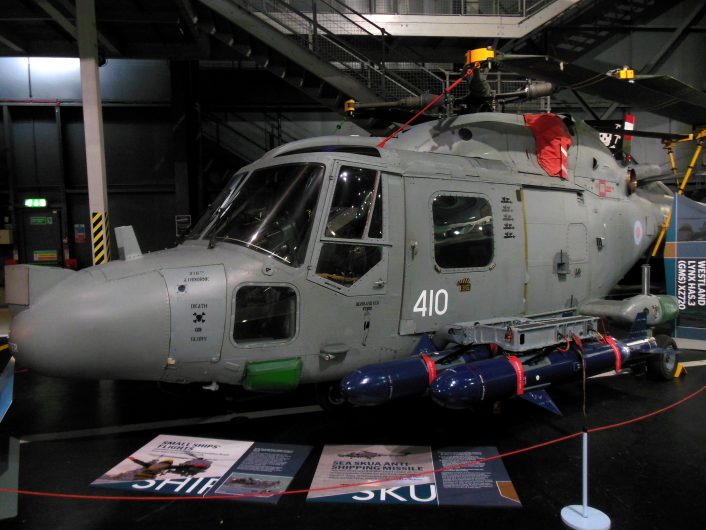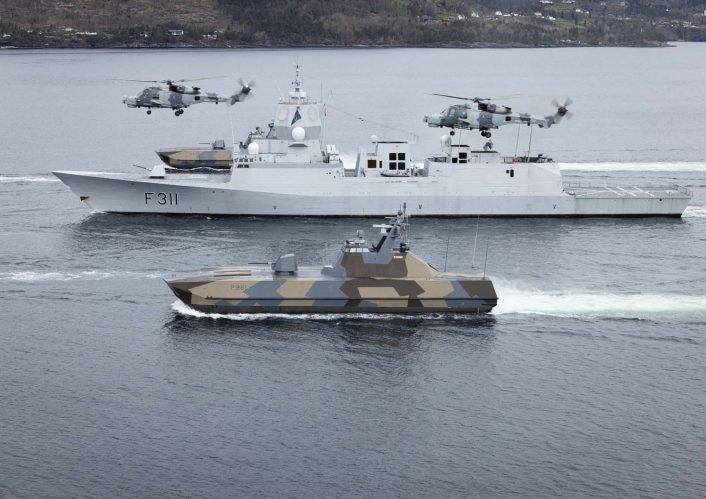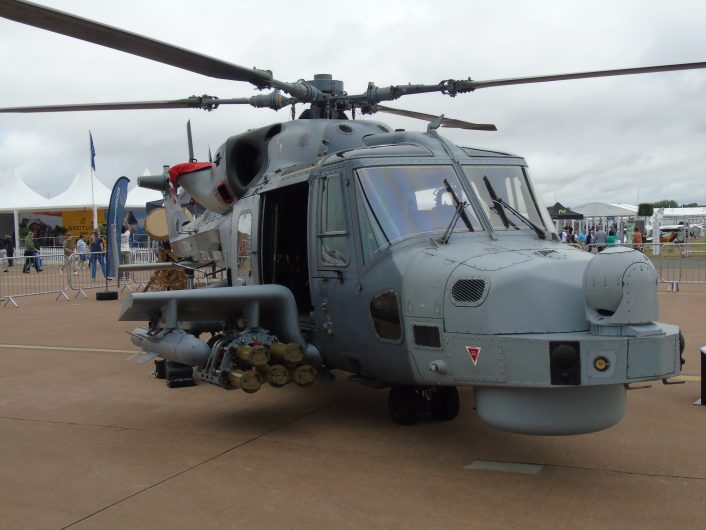A Wildcat HMA2 has successfully test fired a single Sea Venom missile as the Royal Navy marches on to the weapon systems Full Operational Capability (FOC) in 2026.
Originally slated for entry into service in 2023 this test brings the Royal Navy another step closer to fully integrating the Sea Venom onto the Wildcat helicopter.
Conducted at the Ministry of Defence’s Aberporth range off the coast of west Wales, the test saw a single Sea Venom missile launched at a barge, with three shipping containers fixed on top. According to the Royal Navy, “Each container wall had multiple individually controlled heating elements…” in order to simulate the signature of a real vessel.
Lieutenant Commander Robin Kenchington, from the Royal Navy’s test and evaluation squadron, 744 Naval Air Squadron (NAS), stated that, “The Wildcat has another potent addition to its arsenal, increasing the ability of front-line crews to fight from a greater stand-off distance; this maximizes their lethality whilst keeping them safe from enemy defences.”
The team behind the test firing consisted of members of the armed forces, in collaboration with industry partners across Leonardo UK, MBDA and QinetiQ.
The first venomous bite from a Wildcat…
The #RoyalNavy’s Wildcat maritime attack helicopters will soon pack an even bigger punch after a milestone firing of the new Sea Venom missile, which is designed to destroy enemy warships and attack craft.
Click video to read more.
— Royal Navy (@RoyalNavy) October 9, 2024
Sea Venom
The Sea Venom is a lightweight anti-ship weapon with a range exceeding 20 km and equipped with a 30 kg warhead capable of destroying targets up to the size of a corvette. Sea Venom offers operator-in-the-loop capability so that the missile can be directed mid-flight, whether this be for final aim point adjustment, aborting an attack, or for standard retargeting. This offers the Royal Navy a capability beyond standard fire and forget missiles, giving aircrew more control over the targeting of their weapon system.
However, the missile can still be operated in a fire and forget mode in which case it will rely entirely on its on board infrared seeker. This seeker contains advanced image processing allowing the missile to distinguish between decoys and actual targets ensuring the right targets are destroyed in any engagement.

The Anglo-French missile company MBDA began testing on the Sea Venom back in 2017. Since then they have assessed a multitude of its capabilities: the missile’s launch envelope, its release envelope and engagement modes, its low-altitude sea-skimming capability, lock on after launch (LOAL), lock on before launch (LOBL), operator-in-the-loop capability, and its aimpoint refinement. The Sea Venom then finished its qualification tests in 2020 leading up to the present test fire which demonstrates that full integration of the missile onto the Wildcat remains an ongoing development.
Replacing the Sea Skua
The Sea Venom missile is being introduced into service to replace the older and shorter ranged Sea Skua missile which had originally entered service in 1982. Sea Skua was first used operationally against Argentina in the Falklands War, but it soon became the Royal Navy’s stand off weapon of choice against light warships.
Sea Skua was more famous due to its employment during the First Gulf War where it was used by Royal Navy Lynx helicopters in conjunction with British and American fast jet aircraft to destroy Iraqi fast attack craft, minesweepers and patrol craft. In total Sea Skua missiles launched from Lynx helicopters operating from HMS Cardiff, HMS Gloucester, HMS London and HMS Manchester were credited with sinking or disabling 15 Iraqi vessels, from a range of around 5 miles.

Sea Skua’s service came to an end in 2017 to be replaced by the Sea Venom in the same role, but this introduction has been met by significant delays which have meant that the capability has been gapped for almost a decade.
A pre-Initial Operational Capability version of the missile was deployed with the UK’s 2021 Carrier Strike Group and operated by the Wildcats of 815 Naval Air Squadron aboard the Royal Navy’s escort fleet, to provide an initial light attack capability.
Tamber Shield
Wildcats have been seen carrying dummy versions of the Sea Venom on exercises where they were used to enable aircrew to familiarise themselves with the tactics required to successfully employ the weapon system.
Martlet in the inlets…
Wildcat fliers from @815NAS honed tactics with their new anti-ship missiles in a new @JEFnations exercise (Tamber Shield) off Bergen against fast-attack craft from @Forsvaret_no and P2000s @HMSArcher and @HMS_Pursuer.
— Royal Navy (@RoyalNavy) May 2, 2023
Exercise Tamber Shield in April 2023 for instance saw Royal Navy Wildcats employed, in the Norwegian Fjords, against Royal Norwegian Navy frigates and corvettes as well as the Royal Navy’s own Archer Class P2000 patrol craft, to develop and test tactics best suited for Sea Venom employment.

However, No live fire tests were conducted during this exercise, making the current test the first live firing of a Sea Venom yet seen from a Royal Navy helicopter.

Once FOC is established the Sea Venom missile will join an array of weapon systems already operational on the Wildcat. This includes the Martlet missile, designed for taking out small boats, patrol craft and light aircraft with a laser guided 3kg warhead. As well as the Sting Ray torpedo designed for targeting subsurface threats with a 45kg warhead. The heavier Sea Venom missile will greatly complement the Martlet, with the two often being seen paired together whilst on training exercises.
Sea Venom was due to be integrated onto the Airbus H160 Guépard for the Marine Nationale, however, these plans have been dropped with the French Navy instead exploring 68mm guided rockets offered by Thales. As a result the UK remains the sole customer for the missile.

For the last few years the Royal Navy has been without modern dedicated anti-ship missiles for its warships and its helicopters. But this test firing marks the return of a core capability which will ensure that the Royal Navy is able to respond to all types of sea based threats

